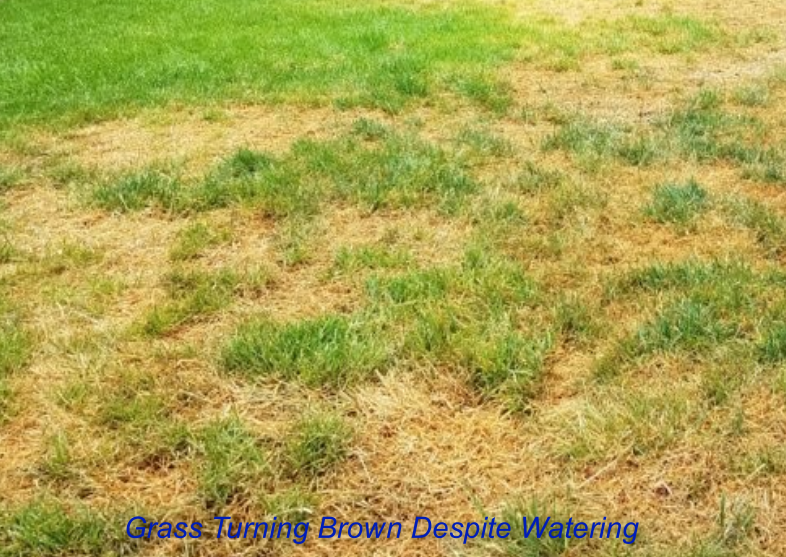Water is one of the key requirements for keeping a lawn green. It’s quite frustrating to realize brown patches in your lawn despite your daily efforts of keeping it hydrated. So, why is your grass turning brown despite watering?
Despite adequate watering, grass can turn brown as a result of diseases, pest infestation, nutritional deficiency, excess soil acidity, poor mowing techniques, weeds, and burns from animals’ urine.
Why is my grass turning brown despite watering?
The following are factors that can cause your lawn grass to turn brown despite watering:
1. Lawn diseases
Lawn diseases will cause your grass to turn brown despite watering. Fungal infections are common causes of brown patches in your lawn. They are prevalent in warm and moist conditions. If not controlled, the small brown patches will grow into huge areas of dead grass.
2. Pest infestation
Chinch bugs and white grubs are the common pests that cause brown patches in your lawn. Grubs will feed on tender roots of grass while Chinch bugs chew on blades. Few white grubs won’t turn your lawn grass brown. However, an infestation will.
Grubs damage roots to cause poor absorption of water and nutrients. On the other hand, chinch bugs feed on the grass by sucking out the plant juice.
3. Nutritional deficiency
If your lawn grass is turning brown, it may be suffering from certain nutritional deficiencies. Grass requires adequate nutrients to flourish. A deficiency of a certain nutrient such as nitrogen is characterized by the browning and yellowing of grass blades. Conduct a soil test to determine which nutrient is inadequate.
4. Excessively high soil acidity
Lawn grass prefers a pH range of 6 to 7. Having tall evergreen trees in your lawn or mulching with fresh leaves can change the pH of the soil gradually. Always conduct a pH test to determine the pH of your lawn soil.
5. Poor mowing techniques
Mowing too low will cause your grass to turn yellow and eventually brown. Excessive mowing significantly reduces the surface area of the leaf. This limits the grass from producing enough energy through photosynthesis. Blunt mowing blades can also damage the edges.
6. Weeds inversion
Weeds compete with grass for water, nutrients, light, space, and other natural resources. When they take control of your lawn, the grass will definitely turn brown. Weeds also host pests and diseases that attack grass.
7. Pet waste
Allowing pets and stray dogs to excrete their waste on your grass will cause brown patches. Urine contains excess nitrogen that will literally burn the grass. Pets also like playing and burrowing holes in your lawn which can damage roots to cause the browning of grass.
8. Season conditions
Cool-season grass will enter dormancy during high summer temperatures. The grass will turn brown despite watering. It will come back to life when temperatures are cool.

How to fix brown lawn grass and make it green
When you know what is ailing your grass, it is ideal to move with speed and fix the problem before it’s out of control. Here is how to fix brown grass fast:
1. Control the threat of fungal infections
Refrain from watering your lawn late in the evening. Wet grass blades overnight will encourage the growth of fungal infections. Be sure to water your grass early in the morning and late afternoon when the sun is still on.
If you notice the symptoms of fungal infections, apply a fungicide to the affected areas. Mowing your lawn weekly and aerating it twice a year can also help to reduce the chances of fungal infections.
2. Get rid of Grubs and Chinch bugs from your lawn
Grubs and Chinch bugs will spend the entire summer munching on grassroots and juices respectively. To control these pests, apply chemical pesticides like carbaryl on the affected area. You can also control Grubs biologically by introducing nematodes into your lawn.
3. Fertilize your lawn appropriately
Conduct a soil test to determine the exact nutrient that is lacking in your soil. Soil test results also suggest the recommended quantities required by your grass. With proper fertilizer application, your lawn grass should be able to turn green fast.
4. Amend lawn soil to the recommended pH
Insert a pH meter into the soil to determine the exact pH value. Grass thrives in a pH range of 6 to 7, if it’s too low, amend the soil by applying lime to increase the pH. If it’s too high, lower it to the recommended range by applying sulfur.
5. Get rid of weeds in your lawn grass
Weeds compete with your grass for water, nutrients, and other natural resources. Uproot all the present weeds in your lawn, and apply re-emergent or herbicides to prevent new weeds from germinating. Timely weed control will promote green and healthy lawn grass.
6. Prevent pets and stray dogs from accessing your lawn
Provides your pets with alternative playground areas to reduce the chances of urinating on your grass. Installing motion sensor sprinklers in your lawn can also help to deter stray dogs from invading your lawn.
7. Mow your lawn grass appropriately
Mow your lawn at an appropriate height of 2½ inches to encourage green sprout growth. Also, be sure to sharpen your lawn mower blade before using it to minimize injuries on the leaf blades. Mow 3 inches and above in summer. Taller grass will shade roots and reduce water loss through evaporation.
Does grass come back after turning brown?
There is no way you can revive dead grass. However, you can nature brown or yellow grass and bring it back to green and healthy. The secrete is in identifying your lawn problem and fixing them.
Additionally, observe critical lawn care maintenance practices such as aerating the lawn, mowing, adequate watering, fertilizing, weed control, and pest and disease control to help revive brown grass quickly.